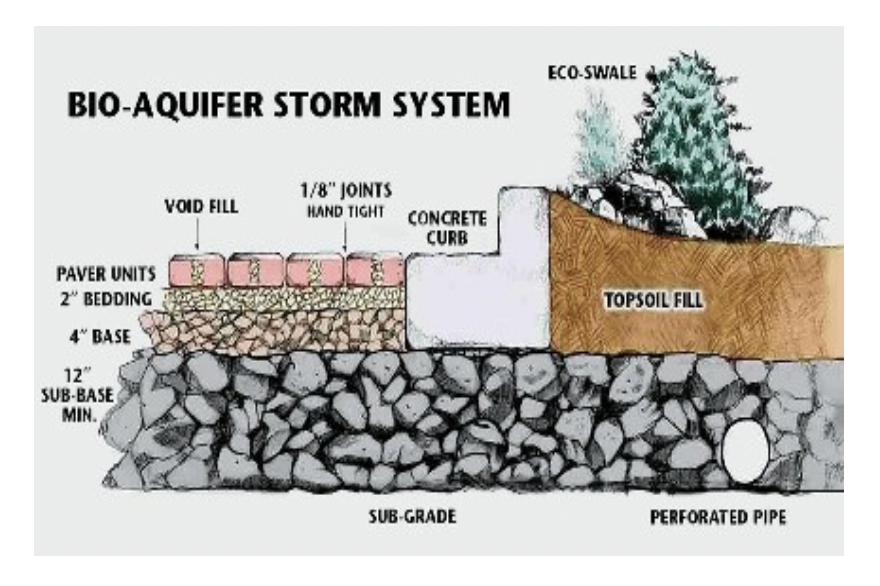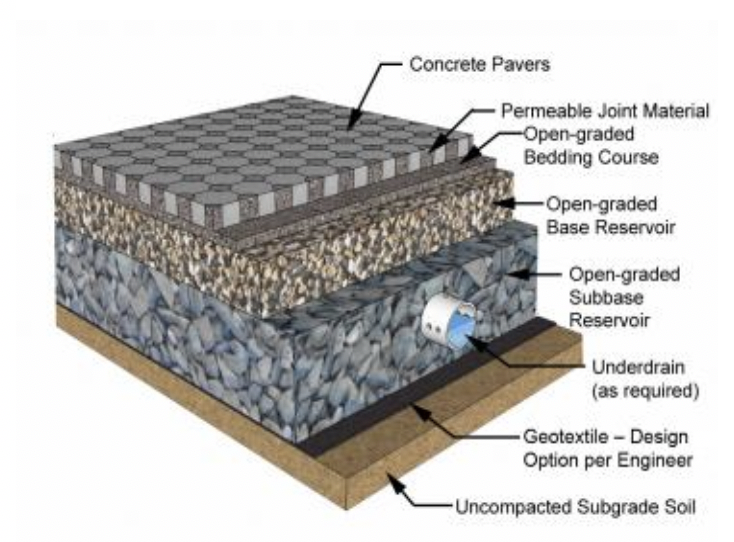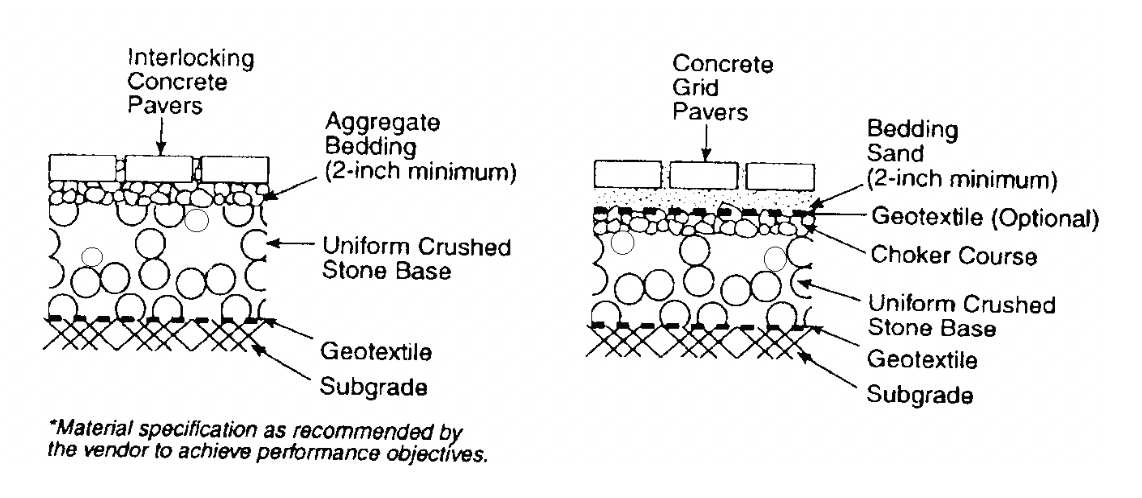Pervious Hardscape Materials
New CommercialWhat are Pervious Hardscape Materials?
Pervious paving systems absorb water rather than diverting water into underlying soils, reducing runoff and treating pollutants as water passes through soils and replenishes groundwater.[1] Stormwater runoff occurs when precipitation, of all forms, falls on land or impervious surfaces and does not infiltrate into the ground. When the runoff flows over the land or impermeable surfaces, including impervious paved surfaces, it combines with pollutants such as debris, chemicals, and sediments. This polluted stormwater can negatively affect the hydrology and water quality of local water sources, resulting in habitat modification and loss, increased flooding, decreased biological diversity, increased sedimentation and erosion, contaminated drinking water, and forced beach closings due to health threats to swimmers.[2]
Green Infrastructure refers to stormwater management practices, such as pervious hardscape materials, that capture, filter, absorb, and reuse stormwater, restoring the natural water cycle, reducing stormwater runoff, promoting infiltration, and enhancing evapotranspiration (see Rain Barrels and Cisterns and Vegetated Roofs).[3] Pervious surfaces include pervious concrete, porous asphalt, interlocking concrete pavers, and grid pavers for use in low traffic areas, parking areas, and walking paths.
The essential components of pervious surfaces include:[4]
- Uncompacted subgrade (original, undisturbed soil)
- Base layer/filter fabric/geotextile
- Uniform crushed stone base
- Porous layer (pavement/paver/brick/stone)

Figure 1 – Pervious hardscape (Source: Design New Jersey/Cambridge Pavers).
How to Use Pervious Hardscape Materials
Review municipal regulations for permission to use pervious paving materials and consult with local officials and Soil Conservation Districts.
Proper installation and base materials such as open-grade crushed stone maximize the surface’s ability to absorb and store water.[5] Figures 2 and 3 illustrate the components of typical permeable concrete paver systems.

Figure 2- Schematic layer design of pervious hardscape; concrete pavers. (Source: Interlocking Concrete Pavement Institute, 2010).

Figure 3- Typical construction of pervious paving (Source: NJ DEP – Standard for Pervious Paving Systems).
Maintenance and Tips
- Consider using salvaged bricks or recycled stone pavers.
- Look for a regionally-quarried stone to reduce transportation costs and environmental footprint.
- To prevent clogging, immediately clean any soil deposited on pavement and vacuum (as necessary) twice each year.
- Maintain planted areas adjacent to the pavement.
For additional information regarding the design of pervious pavement, see the NJ DEP Stormwater Best Practices Manual and the Green Infrastructure Guidance Manual for NJ.
Examples
US EPA Region 2 Laboratory Parking Lot, Edison, NJ
This demonstration project in Edison NJ included three types of permeable surfaces for a 110-vehicle-capacity parking lot. The project leveraged funding from US EPA’s Office of Research and Development (ORD) long-term research project examining various stormwater management practices and installed instrumentation to study the impact of permeable surfaces on stormwater quanitity and quality, erosion, and threats to aquatic life.[6]
Altoona Downtown Revitalization – Altoona, PA
A collaborative effort initiated by downtown business owners and other stakeholders resulted in over 42,000 SF of pervious pavers. A combination of pervious hardscapes was chosen depending on the application, from pavers to withstand traffic loads to compact stone for pedestrians.
Morton Arboretum Visitor’s Center Parking Lot – Lisle, IL
Rather than create detention facilities to address water runoff from required hardscapes (entrance road, passenger drop-off, parking lot), Morton Arboretum opted for permeable pavers covering 173,000 SF, allowing the site design to protect water quality and facilitate water management.
A one-acre park designed with green infrastructure such as bioswales, rain gardens, permeable pavement, and underground chambers that can store 200,000 gallons of stormwater runoff, South Park in Hoboken NJ helps reduce localized flooding in the surrounding neighborhood (see Rain Gardens).
Benefits
Using pervious hardscape materials:
- Alleviates the rate and quantity of stormwater runoff, thus mitigates flooding.
- Reduces pollution of total suspended solids and nutrients in the soil.
- Helps reduce the need for and size of detention ponds, thereby reducing the need to clear more land and wildlife habitats.
Costs
Costs for pervious paving materials vary by the project. The size of the project, local labor expenses, and the type of material all influence the final costs. Cost comparisons for paving materials can be misleading. For example, on average, a standard asphalt installation costs between $3.00 – $3.25 per square foot requires additional stormwater management systems, whereas pervious paving systems incorporate stormwater management.[7]
A more accurate cost comparison considers stormwater management costs. When asphalt projects consider stormwater management costs, for example, the cost rises to between $7 and $15 per square foot.[8] Gravel pavers typically cost between $3.00 and $10.00 per square foot, while interlocking concrete pavers cost between $6.00 and $15.00 per square foot, and porous concrete cost ranges from $4.00 to $6.00 per square foot.[9] [10] While these pervious paving materials may cost more initially than conventional asphalt, longer lifespans due to the higher durability inherent in concrete, reduce long-term maintenance costs and reduce repair costs and premature replacement.[11]
Resiliency
Green infrastructure, such as pervious hardscape materials, integrates resilient and green design to complement and reduce reliance on traditional “grey” infrastructure. For example, pervious hardscape materials help to increase stormwater infiltration, reducing stress on municipal sewer systems during heavy rain events and help to recharge groundwater, during periods of drought.
[1] NJ DEP. Green Infrastructure in NJ. Pervious Pavement. http://www.nj.gov/dep/gi/ (accessed April 3, 2018).
[2] US EPA National Pollutant Discharge Elimination System (NPDES) Stormwater Program https://www.epa.gov/npdes/npdes-stormwater-program (accessed April 2, 2018).
[3] Rutgers NJ Agricultural Experiment Station – Water Resources Program – Green Infrastructure Guidance Manual for New Jersey http://water.rutgers.edu/GreenInfrastructureGuidanceManual.html (accessed April 2, 2018).
[4] NJ DEP. New Jersey Stormwater Best Practices Manual. “Best Practices Standard for Pervious Paving Systems.” http://www.state.nj.us/dep/stormwater/bmp_manual/NJ_SWBMP_9.7.pdf (accessed March 24, 2018).
[5] NJ DEP. New Jersey Stormwater Best Practices Manual. “Best Practices Standard for Pervious Paving Systems” http://www.nj.gov/dep/stormwater/pdf/2016-11-07-pervious-paving-final.pdf (accessed March 24, 2018).
[6] US EPA. https://www.epa.gov/water-research/experimental-permeable-pavement-parking-lot-and-rain-garden-stormwater-management (accessed March 24, 2018).
[7] Costs provided by a significant asphalt supplier in NJ (May 14, 2018).
[8] Prince George’s County Department of the Environment. “Permeable Pavement Fact Sheet.” https://cbtrust.org/wp-content/uploads/Fact-Sheet-and-Guidelines_Permeable-Pavement_042120.pdf (accessed March 24, 2018).
[9] Homeadvisor.com. https://www.homeadvisor.com/cost/outdoor-living/install-asphalt-paving/ (accessed March 24, 2018).
[10] Improvenet.com. https://www.improvenet.com/r/costs-and-prices/driveway-pavers (accessed March 24, 2018).
[11] Prince George’s County Department of the Environment. “Permeable Pavement Fact Sheet.”
Related Strategies
Resources
- NJ Developers’ Green Infrastructure Guide
- Interlocking Concrete Pavement Institute
- Landscape Architecture Foundation
- Rutgers NJ Agricultural Experiment Station – Water Resources Program – Green Infrastructure
- The Sustainable Sites Initiative
- Water Environment Federation
NJ Department of Environmental Protection
US Environmental Protection Agency
